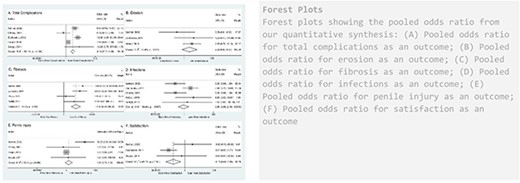-
PDF
- Split View
-
Views
-
Cite
Cite
Mohamed Elmarasi, Dr Ahmad Alsaeedi, Ibrahim Elmakaty, Basel Elsayed, Dr Ibrahim A Khalil, Dr Maya Aldeeb, Dr Kareim Khalafalla, Dr Khalid Al Kubaisi, Dr Mohamed Arafa, Dr Ahmad Majzoub, (1021) EARLY VS DELAYED INSERTION OF PENILE PROSTHESIS IN PATIENTS WITH REFRACTORY PRIAPISM: A SYSTEMATIC REVIEW AND META-ANALYSIS, The Journal of Sexual Medicine, Volume 21, Issue Supplement_4, May 2024, qdae041.025, https://doi.org/10.1093/jsxmed/qdae041.025
Close - Share Icon Share
Abstract
To evaluate and compare the clinical outcomes associated with early versus delayed PP implantation in individuals with priapism-induced erectile dysfunction (ED).
We included studies that focused on refractory priapism leading to ED and its management with PP implantation. We assessed cohort study bias with the risk of bias tool and case series bias with the modified Newcastle-Ottawa scale. Pooled odds ratios (ORs) were calculated using a fixed-effect model.
We included nine studies, comprising four cohort studies and five case series, involving a combined total of 278 patients. Total complications were higher in the delayed group (OR 4.16; 95% confidence interval [CI] 2.77 to 6.26). Fibrosis was significantly more pronounced in the delayed PP group, with an OR of 118.18 (95%CI 20.06 to 696.32). The odds of erosion, infections, and penile injury did not show statistically significant differences between the two groups (OR 2.52; 95%CI 0.67 to 9.49), (OR 0.89; 95%CI 0.38 to 2.10), and (OR 1.83; 95%CI 0.79 to 4.26), respectively. Patients' satisfaction resulted in a pooled OR of 0.15 (95%CI 0.04 to 0.49) in favor of the early PP insertion group.
The results from this study favor an early (within 30 days) approach to ED following ischemic priapism. However, it is important to consider patients’ preferences, values, and psychological factors to make an informed decision.
The authors of this paper declare no conflict of interests associated with this research.




